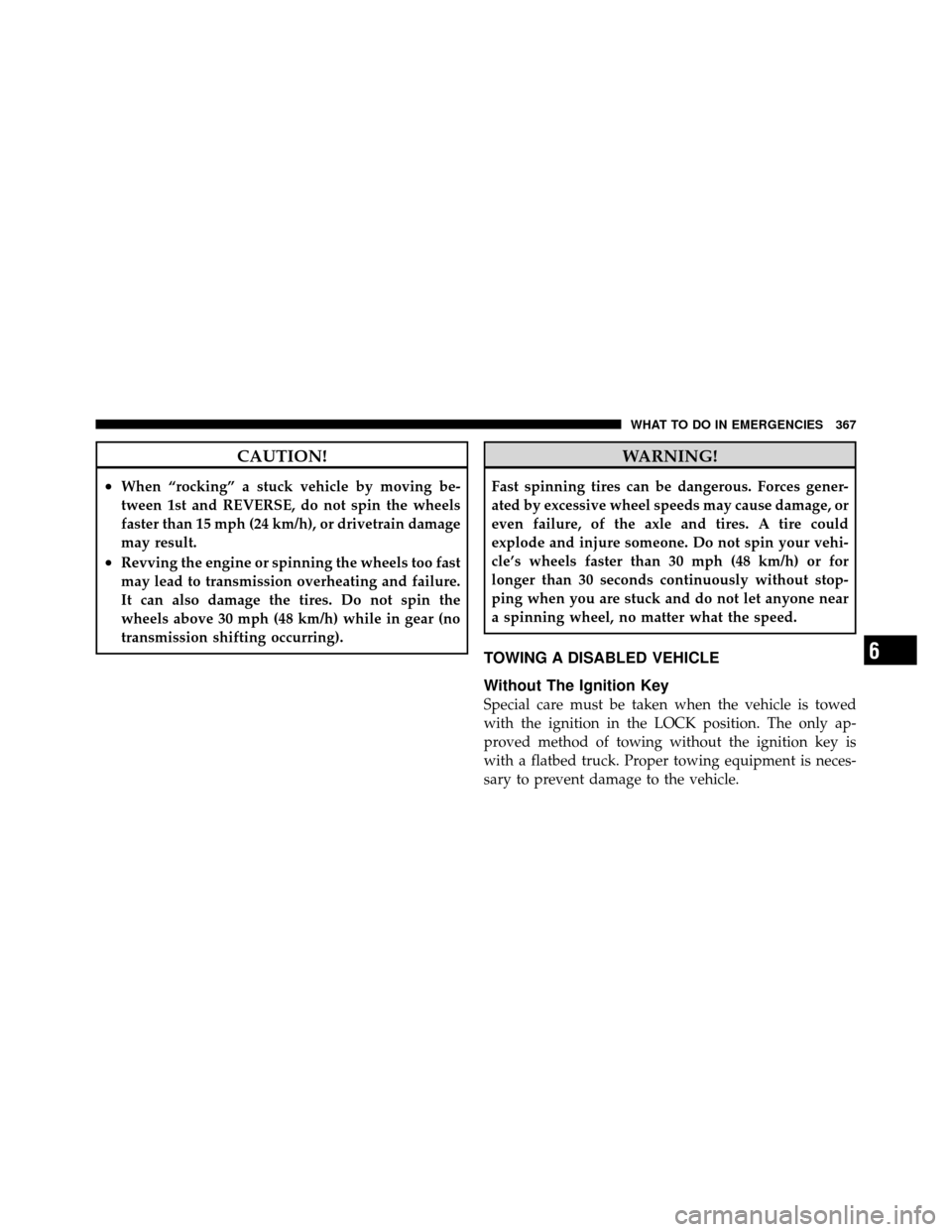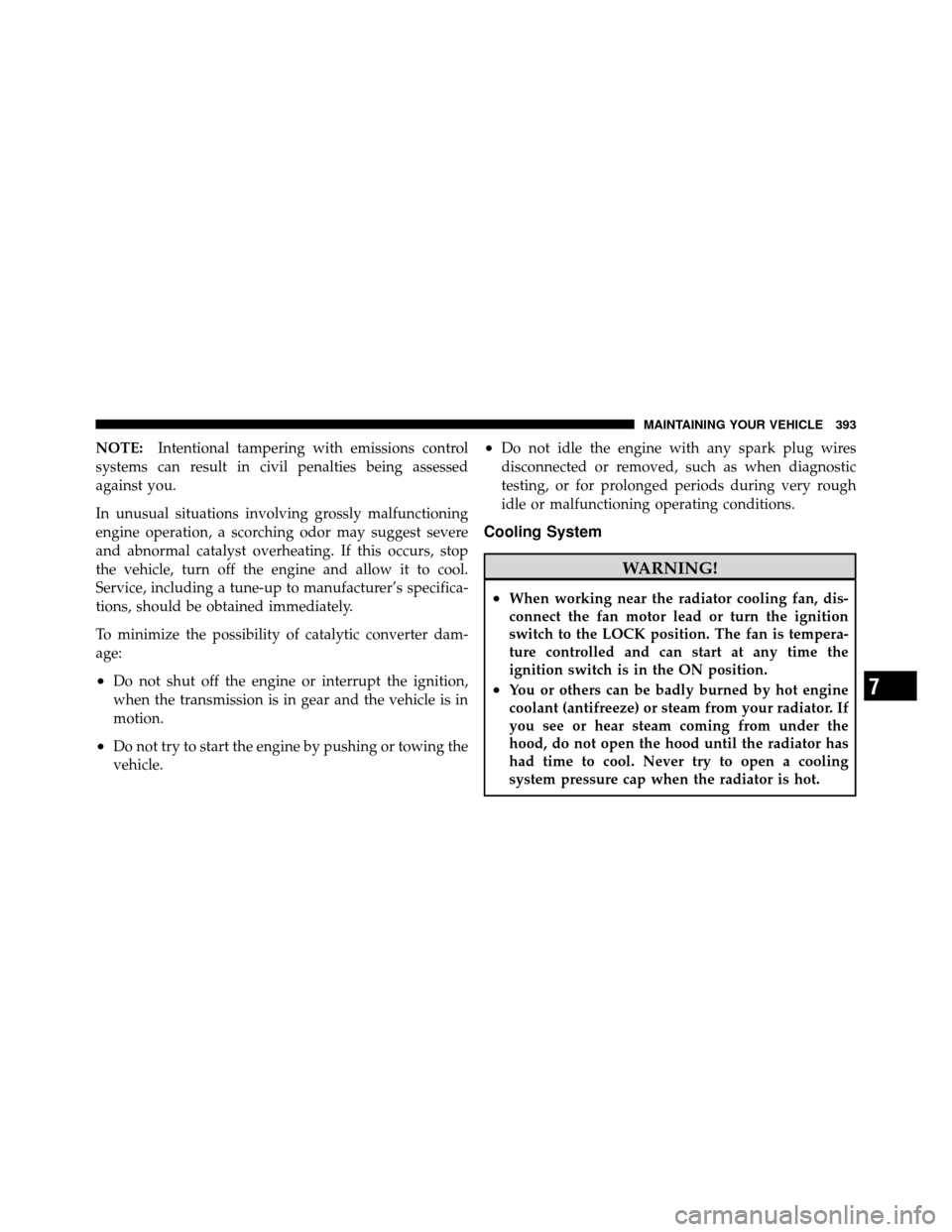Page 368 of 484

CAUTION!
•When “rocking” a stuck vehicle by moving be-
tween 1st and REVERSE, do not spin the wheels
faster than 15 mph (24 km/h), or drivetrain damage
may result.
•Revving the engine or spinning the wheels too fast
may lead to transmission overheating and failure.
It can also damage the tires. Do not spin the
wheels above 30 mph (48 km/h) while in gear (no
transmission shifting occurring).
WARNING!
Fast spinning tires can be dangerous. Forces gener-
ated by excessive wheel speeds may cause damage, or
even failure, of the axle and tires. A tire could
explode and injure someone. Do not spin your vehi-
cle’s wheels faster than 30 mph (48 km/h) or for
longer than 30 seconds continuously without stop-
ping when you are stuck and do not let anyone near
a spinning wheel, no matter what the speed.
TOWING A DISABLED VEHICLE
Without The Ignition Key
Special care must be taken when the vehicle is towed
with the ignition in the LOCK position. The only ap-
proved method of towing without the ignition key is
with a flatbed truck. Proper towing equipment is neces-
sary to prevent damage to the vehicle.
6
WHAT TO DO IN EMERGENCIES 367
Page 390 of 484

Refer to “Maintenance Schedule” for the proper mainte-
nance intervals.
Body Lubrication
Locks and all body pivot points, including such items as
seat tracks, door hinge pivot points and rollers, liftgate,tailgate, sliding doors and hood hinges, should be lubri-
cated periodically with a lithium based grease, such as
MOPAR�
Spray White Lube or equivalent to assure
quiet, easy operation and to protect against rust and
wear. Prior to the application of any lubricant, the parts
concerned should be wiped clean to remove dust and
grit; after lubricating excess oil and grease should be
removed. Particular attention should also be given to
hood latching components to ensure proper function.
When performing other underhood services, the hood
latch, release mechanism and safety catch should be
cleaned and lubricated.
The external lock cylinders should be lubricated twice a
year, preferably in the Fall and Spring. Apply a small
amount of a high quality lubricant, such as MOPAR�
Lock Cylinder Lubricant or equivalent directly into the
lock cylinder.
A/C Air Filter
7
MAINTAINING YOUR VEHICLE 389
Page 394 of 484

NOTE:Intentional tampering with emissions control
systems can result in civil penalties being assessed
against you.
In unusual situations involving grossly malfunctioning
engine operation, a scorching odor may suggest severe
and abnormal catalyst overheating. If this occurs, stop
the vehicle, turn off the engine and allow it to cool.
Service, including a tune-up to manufacturer’s specifica-
tions, should be obtained immediately.
To minimize the possibility of catalytic converter dam-
age:
•Do not shut off the engine or interrupt the ignition,
when the transmission is in gear and the vehicle is in
motion.
•Do not try to start the engine by pushing or towing the
vehicle.
•Do not idle the engine with any spark plug wires
disconnected or removed, such as when diagnostic
testing, or for prolonged periods during very rough
idle or malfunctioning operating conditions.
Cooling System
WARNING!
•When working near the radiator cooling fan, dis-
connect the fan motor lead or turn the ignition
switch to the LOCK position. The fan is tempera-
ture controlled and can start at any time the
ignition switch is in the ON position.
•You or others can be badly burned by hot engine
coolant (antifreeze) or steam from your radiator. If
you see or hear steam coming from under the
hood, do not open the hood until the radiator has
had time to cool. Never try to open a cooling
system pressure cap when the radiator is hot.7
MAINTAINING YOUR VEHICLE 393
Page 412 of 484
Cavity Car-tridge
FuseMini-
Fuse
Description
9 ———
10 30 Amp Pink— Windshield Wiper
11 30 Amp Pink— Anti-Lock Brake System
(ABS) Valves – If
Equipped
12 40 Amp Green— Radiator Fan
13 50 Amp Red— Anti-Lock Brake System
(ABS) Pump Motor – If
Equipped
14———Cavity Car- tridge
FuseMini-
Fuse
Description
15 50 Amp Red— Radiator Fan
16———
17———
18———
19———
20———
21———
22———
7
MAINTAINING YOUR VEHICLE 411
Page 419 of 484

ExteriorBulb Number
Low Beam Headlamp (Standard Halogen) ......9006
Low Beam Headlamp – High Intensity
Discharge (HID) ......................... D1S
(Serviced at Authorized Dealer)
High Beam Headlamp .................... 9005
Front Park/Turn Lamp ................... 3157A
Front Fog Lamp – If Equipped ............PSX24W
Front Side Marker ........................ 194
(Serviced at Authorized Dealer)
Tail/Stop Lamp ......................... 3057
Tail/Turn Lamp ......................... 3057
Rear Side Marker ........................ 168
Backup Lamp ........................... 921
Center High-Mount Stop Lamp (CHMSL) ....... LED
(Serviced at Authorized Dealer)
License ................................ 168BULB REPLACEMENT
Low Beam Headlamp, High Beam Headlamp,
Park/Turn Lamp, and Front Side Marker Lamp —
Models with Halogen Headlamps
1. Open the hood.
NOTE: Removal of the air cleaner filter housing may be
necessary prior to replacing bulbs in the headlamp
assembly on the driver side of the vehicle.
2. Twist the appropriate bulb and socket assembly coun-
terclockwise, and then pull it out of the headlamp
assembly.
418 MAINTAINING YOUR VEHICLE
Page 420 of 484
CAUTION!
Do not touch the new bulb with your fingers. Oil
contamination will severely shorten bulb life. If the
bulb comes in contact with an oily surface, clean the
bulb with rubbing alcohol.
3. Disconnect the bulb from the socket assembly and
install the replacement bulb.
4. Reinstall the bulb and socket assembly into the head-
lamp assembly, and then turn it clockwise.
1 — High Beam Headlamp Bulb
2 — Low Beam Headlamp Bulb
7
MAINTAINING YOUR VEHICLE 419
Page 423 of 484
Backup Lamp, Side Marker Lamp, Tail/Turn Lamp,
and Tail/Stop Lamp
1. Open the trunk.
2. Remove two fasteners from the back of the taillamp
assembly.
3. Pull back the trunk liner.4. Remove the remaining fastener from the back of the
taillamp assembly.
5. Push the electrical connector locking tab to the side.
6. Disconnect the electrical connector.
7. Pull the taillamp assembly clear from the vehicle to
access the bulbs.
422 MAINTAINING YOUR VEHICLE
Page 424 of 484
8. Turn the appropriate bulb and socket assembly coun-
terclockwise to remove it from the taillamp assembly.
1 — Backup Lamp Bulb
2 — Side Marker Lamp Bulb
7
MAINTAINING YOUR VEHICLE 423